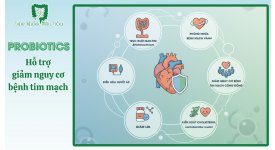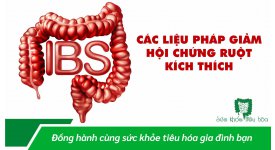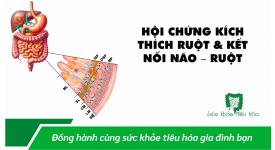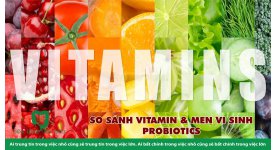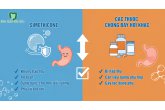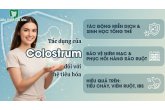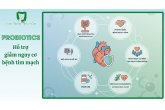XEM XÉT LỢI ÍCH SỨC KHỎE CỦA PROBIOTIC (SONG NGỮ)
|
HEALTH BENEFITS OF PROBIOTICS: A REVIEW |
XEM XÉT LỢI ÍCH SỨC KHỎE CỦA PROBIOTIC | |
|
1. Introduction The reported beneficial effects of probiotic consumption include improvement of intestinal health, amelioration of symptoms of lactose intolerance, and reduction of the risk of various other diseases, and several well-characterized strains of Lactobacilli and Bifidobacteria are available for human use [3, 4]. Nevertheless, despite the promising evidence, the role of probiotics in human health as well as the safety of their application should be further investigated as the current knowledge of the characteristics that are necessary for their functionality in the gut is not complete. |
1. Giới thiệu Các tác dụng có lợi được báo cáo của việc tiêu thụ men vi sinh bao gồm cải thiện sức khỏe đường ruột, cái thiện các triệu chứng không dung nạp đường lactose trong sữa và giảm nguy cơ mắc các bệnh khác nhau và một số chủng Lactobacilli và Bifidobacteria đặc trưng có nhiều lợi ích sức khỏe cho người sử dụng [3, 4]. Tuy nhiên, mặc dù có bằng chứng đầy hứa hẹn, vai trò của men vi sinh đối với sức khỏe con người cũng như sự an toàn khi sử dụng chúng vẫn cần được nghiên cứu thêm vì kiến thức hiện tại về các đặc điểm cần thiết cho chức năng của chúng trong ruột chưa hoàn chỉnh. |
|
|
2. Definition of Probiotics and Other Related Terms “Probiotics are live microbial feed supplements which beneficially affect the host animal by improving microbial balance” [6]. The definition used at present was given by the Food and Agriculture Organization of the United Nations World Health Organization, according to which probiotics are redefined as “live microorganisms which when administered in adequate amounts confer a health benefit on the host.” In relation to food the definition can be adjusted by emphasizing that the beneficial effect is exerted by the microorganisms “when consumed in adequate amounts as part of food” [7]. The term prebiotics was introduced by Gibson and Roberfroid in 1995 to describe food supplements that are nondigestible by the host but are able to exert beneficial effects by selective stimulation of growth or activity of microorganisms that are present in the intestine. Prebiotic substances are not hydrolysed nor absorbed in the gastrointestinal tract but are available as substrates for probiotics and the most commonly used ones at present are nondigestible fructooligosaccharides. For practical reasons the combination of probiotics and prebiotics has been described as conbiotics by certain authors and as symbiotics by others [8, 9]. Although prebiotics seem to have a role in health promotion this needs to be supported by further studies. During the last years the concept of functional food has also been developed in order to describe foods containing ingredients with positive effects on host health beyond their nutritive value. They include those products that contain biologically active components that improve health, such as probiotics [1].
|
2. Định nghĩa về Probiotic và các điều khoản liên quan khác Probiotic là thực phẩm bổ sung vi khuẩn sống ảnh hưởng có lợi đến vật chủ bằng cách cải thiện cân bằng vi khuẩn [6]. Định nghĩa được sử dụng hiện nay được đưa ra bởi Tổ chức Lương thực và Nông nghiệp của Tổ chức Y tế Thế giới Liên Hiệp Quốc, theo đó, probiotics được định nghĩa lại là vi sinh vật sống khi được dùng đủ lượng sẽ mang lại lợi ích sức khỏe cho vật chủ. Liên quan đến thực phẩm, định nghĩa có thể được điều chỉnh bằng cách nhấn mạnh rằng tác dụng có lợi được các vi sinh vật gây ra khi được tiêu thụ với số lượng đầy đủ như một phần của thực phẩm [7]. Thuật ngữ prebiotic được Gibson và Roberfroid giới thiệu vào năm 1995 để mô tả các chất bổ sung thực phẩm không thể tiêu hóa được bởi vật chủ nhưng có thể phát huy tác dụng có lợi bằng cách kích thích chọn lọc sự tăng trưởng hoặc hoạt động của các vi sinh vật có trong ruột. Các chất prebiotic không bị thủy phân cũng không được hấp thụ trong đường tiêu hóa nhưng có lợi ích như là chất nền cho men vi sinh và những chất được sử dụng phổ biến nhất hiện nay là fructooligosacarit không tiêu hóa được. Vì những lý do thực tế, sự kết hợp giữa men vi sinh và prebiotic đã được mô tả là conbiotics hay symbiotics bởi một số tác giả khác là hiệu ứng cộng sinh [8, 9]. Mặc dù prebiotic dường như có vai trò trong việc tăng cường sức khỏe, điều này cần được hỗ trợ bởi các nghiên cứu tiếp theo. Trong những năm qua, khái niệm thực phẩm chức năng cũng đã được phát triển để mô tả các loại thực phẩm có chứa các thành phần có tác động tích cực đến sức khỏe của vật chủ ngoài giá trị dinh dưỡng của chúng. Chúng bao gồm những sản phẩm có chứa các thành phần hoạt tính sinh học giúp cải thiện sức khỏe, chẳng hạn như probiotic [1]. |
|
|
3. Microbial Species with Applications as Probiotics Taking into consideration their definition the number of microbial species which may exert probiotic properties is impressive. Some of the most important representatives are listed. As far as nutrition is concerned only the strains classified as lactic acid bacteria are of significance and among them the ones with the most important properties in an applied context are those belonging to the genera Lactococcus and Bifidobacterium [10]. Lactic acid bacteria are Gram-positive, catalase-negative bacterial species able to produce lactic acid as main end-product of carbohydrate fermentation. The genus Bifidobacterium is therefore rather traditionally than phylogenetically listed among them as they use a separate metabolic pathway. Two other species playing an important role in the food industry, particularly dairy products, although not strictly considered as probiotics are Streptococcus thermophilus and Lactococcus lactis, two of the most commercially important lactic acid bacteria [11]. |
3. Loài vi sinh vật với các ứng dụng như Probiotic Xem xét định nghĩa của chúng, một số các loài vi sinh vật có thể gây ra các đặc tính của probiotics là rất ấn tượng. Một số đại diện quan trọng nhất được liệt kê. Về mặt dinh dưỡng, chỉ có các chủng được phân loại là vi khuẩn axit lactic có ý nghĩa quan trọng và trong số đó, những chủng có tính chất quan trọng nhất trong lĩnh vực ứng dụng là những chủng thuộc giống Lactococcus và Bifidobacterium [10]. Vi khuẩn axit lactic là loài vi khuẩn gram dương, catalase âm tính có thể tạo ra axit lactic là sản phẩm cuối cùng của quá trình lên men carbohydrate. Do đó, chi Bifidobacterium khá truyền thống chứ không được liệt kê về mặt phát sinh loài vì chúng sử dụng một con đường trao đổi chất riêng biệt. Hai loài khác đóng vai trò quan trọng trong ngành công nghiệp thực phẩm, đặc biệt là các sản phẩm từ sữa, mặc dù không được coi là probiotics nghiêm ngặt là Streptococcus thermophilus và Lactococcus lactis, hai trong số các vi khuẩn axit lactic quan trọng nhất về mặt thương mại [11]. |
|
|
4. Desirable Probiotic Properties As far as the final product is concerned, the probiotic dose levels should be based on the ones found to be efficacious in human studies and the colony forming units per gram of product is an important parameter. Although the information about the minimum effective concentrations is still insufficient, it is generally accepted that probiotic products should have a minimum concentration of 106 CFU/mL or gram and that a total of some 108 to 109 probiotic microorganisms should be consumed daily for the probiotic effect to be transferred to the consumer. Furthermore, the strains must be able to grow under manufacture and commercial conditions and should retain viability under normal storage conditions [3, 15]. Viability is by definition a prerequisite for probiotic functionality as it potentiates mechanisms such as adherence, reduction of gut permeability, and immunomodulation and constitutes an industrial challenge [16, 17]. |
4. Thuộc tính Probiotic mong muốn Đối với sản phẩm cuối cùng có liên quan, liều dùng của men vi sinh nên dựa trên mức độ hiệu quả trong nghiên cứu ở người và đơn vị hình thành khuẩn lạc trên mỗi gram sản phẩm là một thông số quan trọng. Mặc dù thông tin về nồng độ tối thiểu có hiệu lực vẫn không đủ, khái niệm được chấp nhận rộng rãi là các sản phẩm probiotic nên có nồng độ tối thiểu 106 CFU/ ml hoặc gram và có tổng cộng khoảng 108 đến 109 CFU/ ml vi sinh vật probiotic được tiêu thụ hàng ngày cho tác dụng sinh học được chuyển đến người tiêu dùng. Hơn nữa các chủng phải có khả năng phát triển trong điều kiện sản xuất và thương mại và phải duy trì khả năng tồn tại trong điều kiện bảo quản bình thường [3,15]. Khả năng tồn tại được định nghĩa là một điều kiện tiên quyết cho chức năng của probiotics vì nó tăng cường các cơ chế giảm tính thẩm ruột và điều hòa miễn dịch và tạo thành thách thức trong sản xuất công nghiệp [16, 17]. |
|
|
5. Mechanisms of Probiotic Activity Probiotics have various mechanisms of action although the exact manner in which they exert their effects is still not fully elucidated. These range from bacteriocin and short chain fatty acid production, lowering of gut pH, and nutrient competition to stimulation of mucosal barrier function and immunomodulation. The latter in particular has been the subject of numerous studies and there is considerable evidence that probiotics influence several aspects of the acquired and innate immune response by inducing phagocytosis and IgA secretion, modifying T-cell responses, enhancing Th1 responses, and attenuating Th2 responses [20–22]. |
5. Cơ chế hoạt động của Probiotic Probiotic có nhiều cơ chế hoạt động khác nhau mặc dù cách thức chính xác mà tác dụng của chúng vẫn chưa được làm rõ hoàn toàn. Những phạm vi từ chất kháng khuẩn bacteriocin và sản xuất axit béo chuỗi ngắn, làm giảm pH đường ruột và cạnh tranh dinh dưỡng để kích thích chức năng hàng rào niêm mạc và điều hòa miễn dịch. Đặc biệt sau này đã là chủ đề của nhiều nghiên cứu và có bằng chứng đáng kể rằng probiotics ảnh hưởng đến một số khía cạnh của phản ứng miễn dịch thu được và bẩm sinh bằng cách gây ra thực bào và bài tiết IgA, điều chỉnh phản ứng tế bào T, tăng cường phản ứng Th1 và làm giảm các đáp ứng Th2 [20-22]. |
|
|
6. Health Benefits of Probiotics
There is increasing evidence in favour of the claims of beneficial effects attributed to probiotics, including improvement of intestinal health, enhancement of the immune response, reduction of serum cholesterol, and cancer prevention. These health properties are strain specific and are impacted by the various mechanisms mentioned above. While some of the health benefits are well documented others require additional studies in order to be established. In fact, there is substantial evidence to support probiotic use in the treatment of acute diarrhoeal diseases, prevention of antibiotic-associated diarrhoea, and improvement of lactose metabolism, but there is insufficient evidence to recommend them for use in other clinical conditions. |
6. Lợi ích sức khỏe của men vi sinh
Ngày càng có nhiều bằng chứng ủng hộ tuyên bố về các tác dụng có lợi được quy cho men vi sinh, bao gồm cải thiện sức khỏe đường ruột, tăng cường đáp ứng miễn dịch, giảm cholesterol huyết thanh và phòng chống ung thư. Các đặc tính sức khỏe này là đặc hiệu của chủng và bị ảnh hưởng bởi các cơ chế khác nhau được đề cập ở trên. Trong khi một số lợi ích sức khỏe được ghi nhận tốt, những tài liệu khác yêu cầu các nghiên cứu bổ sung để được hoàn chỉnh. Trên thực tế, có bằng chứng đáng kể để hỗ trợ sử dụng men vi sinh trong điều trị các bệnh tiêu chảy cấp, phòng ngừa tiêu chảy liên quan đến kháng sinh và cải thiện chuyển hóa đường sữa, nhưng không đủ bằng chứng để khuyến nghị sử dụng chúng trong các điều kiện lâm sàng khác. |
|
|
7. Antibiotic-Associated Diarrhoea
A recent meta-analysis evaluating the available evidence on probiotics for the prevention and treatment of antibiotic-associated diarrhoea concluded that probiotic administration- (namely, L. rhamnosus, L. casei, and the yeast S. boulardii, as these are the probiotics predominantly included in the majority of trials) is associated with a reduced risk of the condition. Matters for future research include the optimal dose of the probiotic preparation and the comparative effectiveness of different probiotic interventions [34]. |
7. Tiêu chảy liên quan đến kháng sinh
Một phân tích tổng hợp gần đây đánh giá các bằng chứng có hiệu quả về men vi sinh để phòng ngừa và điều trị tiêu chảy liên quan đến kháng sinh đã kết luận rằng việc sử dụng men vi sinh - (cụ thể là L. rhamnosus, L. casei và nấm men S. boulardii, vì đây là các probiotics chủ yếu bao gồm trong phần lớn các thử nghiệm) có liên quan đến việc giảm nguy cơ mắc bệnh. Các vấn đề cho nghiên cứu trong tương lai bao gồm liều tối ưu của probiotics và hiệu quả so sánh của các biện pháp can thiệp bằng probiotics khác nhau [34].
|
|
|
8. Infectious Diarrhoea
Treatment and prevention of infectious diarrhoea are probably the most widely accepted health benefits of probiotic microorganisms. Rotavirus is the most common cause of acute infantile diarrhoea in the world and a significant cause of infant mortality. The virus replicates in the highly differentiated absorptive columnar cells of the small intestinal epithelium and the normal microflora seems to play an important role in the host response to the infection, as it has been shown that absorption of antigens is more enhanced in germ-free than in normal mice [35]. Probiotic supplementation of infant formulas has been aimed both at the prevention of rotaviral infections and the treatment of established disease. Well-controlled clinical studies have shown that probiotics such as L. rhamnosus GG, L. reuteri, L. casei Shirota, and B. animalis Bb12 can shorten the duration of acute rotavirus diarrhoea with the strongest evidence pointing to the effectiveness of L. rhamnosus GG and B. animalis Bb12 [36–38]. The proposed mechanisms include competitive blockage of receptor site signals regulating secretory and motility defences, enhancement of the immune response, and production of substances that directly inactivate the viral particles. In addition to rotavirus infection there is evidence that certain food as well as nonfood probiotic strains can inhibit the growth and adhesion of a range of diarrhoeal syndromes. The benefit of probiotics such as L. reuteri, L. rhamnosus GG, L. casei, and S. boulardii in reducing the duration of acute diarrhoea in children has been demonstrated, [37, 39]. For example, in a prospective, randomized, controlled French study conducted among children in day care, the administered probiotic yoghurt product containing L. casei shortened the mean duration of diarrhoea significantly compared to the conventional one [40]. Several studies have investigated the efficacy of probiotics in the prevention of travellers' diarrhoea in adults. Although results are quite contradictory, due to differences in study populations, type of probiotic being investigated, applied doses, as well as trip destination and traveller compliance, L. rhamnosus GG, S. boulardii, L. acidophilus, and B. bifidum seem to exhibit significant efficacy [41–43]. Furthermore, numerous animal studies have indicated an inhibitory effect of probiotics against enteropathogens mainly through the production of bacteriocins [44]. |
8. Tiêu chảy nhiễm trùng
Điều trị và ngăn ngừa tiêu chảy nhiễm trùng có lẽ là những lợi ích sức khỏe được chấp nhận rộng rãi nhất của các vi sinh vật probiotic. Rotavirus là nguyên nhân phổ biến nhất của tiêu chảy cấp ở trẻ sơ sinh trên thế giới và là nguyên nhân đáng kể gây tử vong ở trẻ sơ sinh. Vi rút nhân lên trong các tế bào trụ hấp thụ biệt hóa cao của biểu mô ruột non và hệ vi sinh bình thường dường như đóng một vai trò quan trọng trong phản ứng của vật chủ đối với nhiễm trùng, vì nó đã được chứng minh rằng sự hấp thụ kháng nguyên được tăng cường hơn ở chuột vô trùng hơn ở chuột bình thường [35]. Việc bổ sung probiotic vào sữa công thức dành cho trẻ sơ sinh vừa nhằm mục đích ngăn ngừa nhiễm trùng do vi-rút và điều trị bệnh đã phát triển. Các nghiên cứu lâm sàng được kiểm soát tốt đã chỉ ra rằng các probiotics như L. rhamnosus GG, L. reuteri, L. casei Shirota, và B. animalis Bb12 có thể rút ngắn thời gian bị tiêu chảy cấp do rotavirus với bằng chứng rõ ràng nhất cho thấy hiệu quả của L. rhamnosus GG và B. animalis Bb12 [36 - 38]. Các cơ chế được đề xuất bao gồm ngăn chặn cạnh tranh các tín hiệu vị trí thụ thể điều chỉnh khả năng phòng thủ bài tiết và nhu động, tăng cường phản ứng miễn dịch và sản xuất các chất trực tiếp bất hoạt các phần tử virus. Ngoài việc nhiễm vi rút rota, có bằng chứng cho thấy một số thực phẩm cũng như các chủng vi sinh vật không phải thực phẩm có thể ức chế sự phát triển và bám dính của một loạt hội chứng tiêu chảy. Lợi ích của probiotics như L. reuteri, L. rhamnosus GG, L. casei, và S. boulardii trong việc giảm thời gian tiêu chảy cấp ở trẻ em đã được chứng minh, [37 , 39]. Ví dụ, trong một nghiên cứu,, ngẫu nhiên, có đối chứng của Pháp được thực hiện ở trẻ em trong nhà trẻ, sản phẩm sữa chua probiotic được sử dụng có chứa L. casei đã rút ngắn đáng kể thời gian tiêu chảy so với sản phẩm thông thường [40]. Một số nghiên cứu đã điều tra hiệu quả của probiotics trong việc ngăn ngừa bệnh tiêu chảy của một nhóm người đi du lịch. Mặc dù các kết quả khá trái ngược nhau, do sự khác biệt trong các quần thể nghiên cứu, loại probiotic được điều tra, liều lượng sử dụng, cũng như điểm đến của chuyến đi và sự tuân thủ của khách du lịch, L. rhamnosus GG, S. boulardii, L. acidophilus và B. bifidum dường như thể hiện hiệu quả đáng kể [41 - 43]. Hơn nữa, nhiều nghiên cứu trên động vật đã chỉ ra tác dụng ức chế của probiotics chống lại các tác nhân gây bệnh đường ruột chủ yếu thông qua việc sản xuất chất kháng khuẩn [44].
|
|
|
9. Lactose Intolerance
Lactose intolerance is a genetically determined beta-galactosidase deficiency resulting in the inability to hydrolyse lactose into the monosaccharides glucose and galactose. Upon reaching the large bowel the undigested lactose is degraded by bacterial enzymes leading to osmotic diarrhoea. Acquired, usually reversible, causes of beta-galactosidase deficiency include pelvic radiotherapy which damages the mucosa, as well as infection with rotavirus which infects lactase producing cells, and short bowel syndrome. Lactose intolerant individuals develop diarrhoea, abdominal discomfort, and flatulence after consumption of milk or milk products. Although conventional yoghurt preparations, using S. thermophilus and L. delbrueckii ssp. Bulgaricus, are even more effective in this direction, partly because of higher beta-galactosidase activity, improvement of lactose metabolism is a claimed health benefit attributed to probiotics and seems to involve certain strains more than others and in specific concentrations. Therefore and as certain individuals have responded positively to probiotic supplementation, clinicians should consider it as a therapeutic alternative [45, 46]. |
9. Không dung nạp lactose
Không dung nạp lactose là tình trạng thiếu hụt men beta-galactosidase được xác định về mặt di truyền dẫn đến không thể thủy phân lactose thành monosaccharides glucose và galactose. Khi đến ruột già, đường lactose không tiêu hóa được sẽ bị phân hủy bởi các enzym của vi khuẩn dẫn đến tiêu chảy thẩm thấu. Các nguyên nhân mắc phải, thường có thể hồi phục, của việc thiếu hụt beta-galactosidase bao gồm xạ trị vùng chậu làm tổn thương niêm mạc, cũng như nhiễm virus rota gây nhiễm các tế bào sản xuất lactase và hội chứng ruột ngắn. Những người không dung nạp lactose bị tiêu chảy, khó chịu ở bụng và đầy hơi sau khi uống sữa hoặc các sản phẩm từ sữa. Mặc dù các chế phẩm sữa chua thông thường, sử dụng S. thermophilus và L. delbrueckii ssp. Bulgaricus, thậm chí còn hiệu quả hơn theo hướng này, một phần do hoạt tính beta-galactosidase cao hơn, cải thiện chuyển hóa lactose là một lợi ích sức khỏe đã được khẳng định do probiotics và dường như liên quan đến một số chủng nhất định hơn những chủng khác và ở nồng độ cụ thể. Do đó, khi một số cá nhân đã phản ứng tích cực với việc bổ sung probiotic, các bác sĩ lâm sàng nên coi nó như một phương pháp điều trị thay thế [45 , 46 ]. |
|
|
10. Probiotics and Allergy
Recent evidence suggests that exposure to bacteria in early life may exhibit a protective role against allergy and in this context probiotics may provide safe alternative microbial stimulation needed for the developing immune system in infants. In the same time they improve mucosal barrier function, a property that is considered to contribute in moderating allergic response. The role of intestinal microbiota in allergy is supported by observations of their quantitative as well as qualitative differences among children and infants suffering from allergies and healthy ones, the former exhibiting colonization by a more adult-like type of microflora [42, 47–49]. These probiotic effects seem to particularly involve food allergy and atopic dermatitis. The latter is a common chronic relapsing skin disorder of infancy and childhood with hereditary predisposition being an important component of its pathogenesis together with the individual's exposure to environmental allergens. A limited number of strains have been tested for their efficacy in the treatment and prevention of allergy in infants. In a recent study of breast fed infants suffering from atopic eczema B. lactis and L. rhamnosus GG were found to be effective in decreasing the eczema severity. Furthermore L. rhamnosus GG has been found successful in preventing the occurrence of atopic eczema in high risk infants, when supplied prenatally to selected mothers who had at least one first degree relative with atopic eczema, allergic rhinitis, or asthma [50]. Probiotics however have not been very successful in alleviating symptoms of asthma [51]. As far as food allergy is concerned, it is described as an immunologically mediated adverse reaction against dietary antigens leading to secondary intestinal inflammation and disturbances. The mechanisms of the immune modulating effect of L. rhamnosus GG are not entirely understood but seem be related to the antigen's transport across the intestinal mucosa [52]. Recently the use of probiotic preparations in adults with milk hypersensitivity—not lactose intolerance—has been studied, concluding that certain strains may suppress the milk-induced inflammatory response and improve allergy symptoms; nevertheless further study in the field is necessary [53, 54]. |
10. Probiotics và dị ứng
Bằng chứng gần đây cho thấy rằng việc tiếp xúc với vi khuẩn trong giai đoạn đầu đời có thể thể hiện vai trò bảo vệ chống lại dị ứng và trong bối cảnh này, men vi sinh có thể cung cấp kích thích vi sinh thay thế an toàn cần thiết cho hệ thống miễn dịch đang phát triển ở trẻ sơ sinh. Đồng thời, chúng cải thiện chức năng hàng rào niêm mạc, một đặc tính được coi là góp phần điều chỉnh phản ứng dị ứng. Vai trò của hệ vi sinh vật đường ruột trong bệnh dị ứng được hỗ trợ bởi các quan sát về sự khác biệt về số lượng cũng như chất lượng của chúng giữa trẻ em và trẻ sơ sinh bị dị ứng và trẻ khỏe mạnh, hệ vi sinh vật trước đây thể hiện sự xâm chiếm của một loại vi sinh vật giống người lớn hơn [ 42 , 47 - 49]. Những tác động của probiotic này dường như đặc biệt liên quan đến dị ứng thực phẩm và viêm da dị ứng. Loại thứ hai là một chứng rối loạn da tái phát mãn tính phổ biến ở trẻ sơ sinh và thời thơ ấu với khuynh hướng di truyền là một thành phần quan trọng trong quá trình sinh bệnh của nó cùng với việc cá nhân tiếp xúc với các chất gây dị ứng môi trường. Một số chủng hạn chế đã được thử nghiệm về hiệu quả của chúng trong việc điều trị và ngăn ngừa dị ứng ở trẻ sơ sinh. Trong một nghiên cứu gần đây về trẻ bú mẹ bị bệnh chàm dị ứng B. lactis và L. rhamnosus GG đã được phát hiện có hiệu quả trong việc giảm mức độ nghiêm trọng của bệnh chàm. Hơn nữa L. rhamnosus GG đã được phát hiện thành công trong việc ngăn ngừa sự xuất hiện của bệnh chàm cơ địa ở trẻ sơ sinh có nguy cơ cao, khi được cung cấp trước cho những bà mẹ được chọn trước khi sinh có ít nhất một người thân bị chàm dị ứng, viêm mũi dị ứng hoặc hen suyễn mức độ một [50 ]. Tuy nhiên, probiotics không thành công lắm trong việc làm giảm các triệu chứng của bệnh hen suyễn [51]. Liên quan đến dị ứng thực phẩm, nó được mô tả là một phản ứng có hại qua trung gian miễn dịch chống lại các kháng nguyên trong chế độ ăn uống dẫn đến viêm và rối loạn đường ruột thứ phát. Cơ chế của tác dụng điều hòa miễn dịch của L. rhamnosus GG không được hiểu hoàn toàn nhưng dường như có liên quan đến sự vận chuyển của kháng nguyên qua niêm mạc ruột [52]. Gần đây, việc sử dụng các chế phẩm probiotic ở người lớn quá mẫn cảm với sữa - không dung nạp lactose - đã được nghiên cứu, kết luận rằng một số chủng có thể ngăn chặn phản ứng viêm do sữa và cải thiện các triệu chứng dị ứng; tuy nhiên nghiên cứu sâu hơn về lĩnh vực này là cần thiết [53, 54]. |
|
|
11. Other Health Benefits
The list of health benefits mediated by probiotics is not limited to the ones mentioned so far and includes a range of promising effects that require however further human studies in order to be substantiated. There is evidence that probiotic bacteria are dietary components that may play a role in decreasing cancer incidence. The exact mechanisms are under investigation, but studies have demonstrated that certain members of Lactobacillus and Bifidobacterium spp. decrease the levels of carcinogenetic enzymes produced by colonic flora through normalization of intestinal permeability and microflora balance as well as production of antimutagenic organic acids and enhancement of the host's immune system [55, 56]. Furthermore, evidence suggests that food products containing probiotic bacteria could possibly contribute to coronary heart disease prevention by reducing serum cholesterol levels as well as to blood pressure control. Proposed mechanisms include interference with cholesterol absorption from the gut, direct cholesterol assimilation, and production of end fermentation products that affect the systemic levels of blood lipids and mediate an antihypertensive effect.
|
11. Lợi ích sức khỏe khác
Có bằng chứng cho thấy vi khuẩn probiotic là thành phần chế độ ăn uống có thể đóng một vai trò trong việc giảm tỷ lệ mắc bệnh ung thư. Các cơ chế chính xác đang được điều tra nhưng các nghiên cứu đã chứng minh rằng một số chủng của Lactobacillus và Bifidobacterium spp. làm giảm nồng độ enzyme gây ung thư do hệ vi khuẩn đại tràng tạo ra thông qua việc bình thường hóa tính thấm của ruột và cân bằng hệ vi sinh vật cũng như sản xuất axit hữu cơ chống đột biến gen và tăng cường hệ thống miễn dịch của vật chủ [55.56]. Hơn nữa, bằng chứng cho thấy rằng các sản phẩm thực phẩm có chứa vi khuẩn probiotic có thể góp phần ngăn ngừa bệnh tim mạch vành bằng cách giảm mức cholesterol trong huyết thanh cũng như kiểm soát huyết áp. Các cơ chế được đề xuất bao gồm can thiệp vào quá trình hấp thụ cholesterol từ ruột, đồng hóa trực tiếp cholesterol và sản xuất các sản phẩm lên men tác động đến mức độ tổng hợp của lipid máu và làm trung gian hạ huyết áp.
|
|
|
12. Conclusions
There is scientific evidence supporting the incorporation of probiotics in nutrition as a means of derivation of health benefits. This evidence seems adequate concerning the prevention and treatment of certain conditions while simply promising or even controversial when it comes to others. The best documented effects include bowel disorders such as lactose intolerance, antibiotic-associated diarrhoea and infectious diarrhoea, and allergy, and emerging evidence accumulates concerning their potential role in various other conditions. In the same time as relevant consumer awareness grows, such products are becoming increasingly popular and tend to represent one of the largest functional food markets. Nevertheless, the development of probiotics for human consumption is still in its infancy. Further research, in the form of controlled human studies, is needed to determine which probiotics and which dosages are associated with the greatest efficacy and for which patients, as well as to demonstrate their safety and limitations. In addition, the regulatory status of probiotics as food components needs to be established on an international level with emphasis on efficacy, safety, and validation of health claims on food labels.
|
12. Kết luận
Có bằng chứng khoa học ủng hộ việc kết hợp men vi sinh trong dinh dưỡng như một phương tiện mang lại lợi ích sức khỏe. Bằng chứng này có vẻ đầy đủ liên quan đến việc phòng ngừa và điều trị một số điều kiện trong khi hứa hẹn đơn giản hoặc thậm chí gây tranh cãi khi nói đến những bằng chứng khác. Các tác dụng được ghi nhận tốt nhất bao gồm các rối loạn đường ruột như không dung nạp lactose sữa, tiêu chảy liên quan đến kháng sinh và tiêu chảy nhiễm trùng và dị ứng và bằng chứng mới nổi tích lũy liên quan đến vai trò tiềm năng của chúng trong các tình trạng khác. Đồng thời khi nhận thức của người tiêu dùng có liên quan tăng lên, những sản phẩm như vậy ngày càng trở nên phổ biến và có xu hướng đại diện cho một trong những thị trường thực phẩm chức năng lớn nhất. Tuy nhiên, sự phát triển của men vi sinh cho con người vẫn còn trong giai đoạn sơ khai. Nghiên cứu sâu hơn, dưới hình thức nghiên cứu trên người có kiểm soát, là cần thiết để xác định loại men vi sinh nào và liều lượng nào có liên quan đến hiệu quả cao nhất và đối với bệnh nhân nào, cũng như để chứng minh sự an toàn và hạn chế của chúng. Ngoài ra, tình trạng quản lý của probiotics với tư cách là thành phần thực phẩm cần phải được thiết lập ở cấp độ quốc tế, chú trọng đến tính bảo đảm, an toàn và xác nhận các công bố về sức khỏe trên nhãn thực phẩm. |
AustrapharmVN dịch
Dịch từ tài liệu:
Bài viết liên quan



